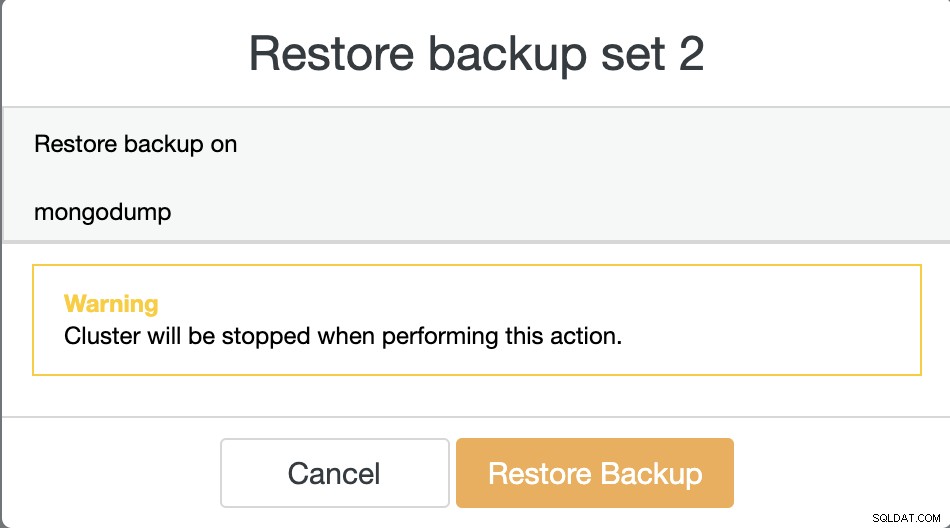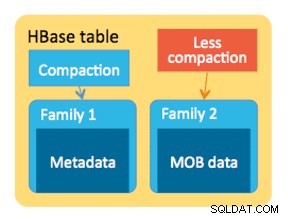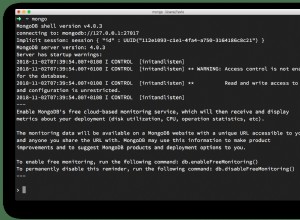अपने डेटाबेस का बैकअप रखना किसी भी उत्पादन परिवेश में सबसे महत्वपूर्ण कार्यों में से एक है। यह आपके डेटा को सुरक्षित रखने के लिए किसी अन्य स्थान पर कॉपी करने की प्रक्रिया है। यह डेटाबेस भ्रष्टाचार या मरम्मत से परे दुर्घटनाग्रस्त डेटाबेस जैसी आपातकालीन स्थितियों से पुनर्प्राप्ति में उपयोगी हो सकता है।
पुनर्प्राप्ति के अलावा, एक बैकअप का उपयोग किसी उत्पादन डेटाबेस की नकल करने के लिए भी किया जा सकता है ताकि किसी भिन्न वातावरण में किसी एप्लिकेशन का परीक्षण किया जा सके, या यहां तक कि कुछ ऐसा डीबग करने के लिए भी किया जा सकता है जो उत्पादन डेटाबेस पर नहीं किया जा सकता है।
डेटाबेस बैकअप के विभिन्न तरीके हैं जिन्हें आप कार्यान्वित कर सकते हैं, डेटाबेस में एम्बेड किए गए टूल का उपयोग करके लॉजिकल बैकअप से (उदाहरण के लिए mysqldump, mongodump, pg_dump) तृतीय पक्ष टूल का उपयोग करके भौतिक बैकअप (उदा। एक्स्ट्राबैकअप, बर्मन, पीजीबैकरेस्ट, मोंगोडब कंसिस्टेंट बैकअप)।
किस विधि का उपयोग करना अक्सर इस बात पर निर्धारित होता है कि आप कैसे पुनर्स्थापित करना चाहते हैं। उदाहरण के लिए, मान लें कि आपने गलती से कोई टेबल या संग्रह गिरा दिया है। यह असंभव है क्योंकि यह प्रतीत हो सकता है, ऐसा होता है। तो पुनर्प्राप्त करने का सबसे तेज़ तरीका संपूर्ण डेटाबेस को पुनर्स्थापित करने के बजाय केवल उस तालिका या संग्रह को पुनर्स्थापित करना होगा।
मोंगोडब में बैकअप और पुनर्स्थापना
Mongodump और mongorestore, MongoDB में उपयोग किए जाने वाले तार्किक बैकअप के लिए उपकरण है, यह MySQL में mysqldump की तरह है, या PostgreSQL में pg_dump है। जब आप MongoDB स्थापित करते हैं तो mongodump और mongorestore उपयोगिता को शामिल किया जाएगा और यह डेटा को BSON प्रारूप में डंप करता है। Mongodump का उपयोग डेटाबेस को डंप फ़ाइलों में तार्किक रूप से बैकअप करने के लिए किया जाता है, जबकि mongorestore का उपयोग पुनर्स्थापना ऑपरेशन के लिए किया जाता है।
mongodump और mongorestore कमांड का उपयोग करना आसान है, हालांकि बहुत सारे विकल्प हैं।
जैसा कि हम नीचे देख सकते हैं, आप विशिष्ट डेटाबेस या संग्रह का बैकअप ले सकते हैं। आप oplog को शामिल करके समय का एक स्नैपशॉट भी ले सकते हैं।
[email protected]:~# mongodump --help
Usage:
mongodump <options>
Export the content of a running server into .bson files.
Specify a database with -d and a collection with -c to only dump that database or collection.
See http://docs.mongodb.org/manual/reference/program/mongodump/ for more information.
general options:
--help print usage
--version print the tool version and exit
verbosity options:
-v, --verbose=<level> more detailed log output (include multiple times for more verbosity, e.g. -vvvvv, or specify a numeric value, e.g. --verbose=N)
--quiet hide all log output
connection options:
-h, --host=<hostname> mongodb host to connect to (setname/host1,host2 for replica sets)
--port=<port> server port (can also use --host hostname:port)
kerberos options:
--gssapiServiceName=<service-name> service name to use when authenticating using GSSAPI/Kerberos ('mongodb' by default)
--gssapiHostName=<host-name> hostname to use when authenticating using GSSAPI/Kerberos (remote server's address by default)
ssl options:
--ssl connect to a mongod or mongos that has ssl enabled
--sslCAFile=<filename> the .pem file containing the root certificate chain from the certificate authority
--sslPEMKeyFile=<filename> the .pem file containing the certificate and key
--sslPEMKeyPassword=<password> the password to decrypt the sslPEMKeyFile, if necessary
--sslCRLFile=<filename> the .pem file containing the certificate revocation list
--sslAllowInvalidCertificates bypass the validation for server certificates
--sslAllowInvalidHostnames bypass the validation for server name
--sslFIPSMode use FIPS mode of the installed openssl library
authentication options:
-u, --username=<username> username for authentication
-p, --password=<password> password for authentication
--authenticationDatabase=<database-name> database that holds the user's credentials
--authenticationMechanism=<mechanism> authentication mechanism to use
namespace options:
-d, --db=<database-name> database to use
-c, --collection=<collection-name> collection to use
uri options:
--uri=mongodb-uri mongodb uri connection string
query options:
-q, --query= query filter, as a JSON string, e.g., '{x:{$gt:1}}'
--queryFile= path to a file containing a query filter (JSON)
--readPreference=<string>|<json> specify either a preference name or a preference json object
--forceTableScan force a table scan
output options:
-o, --out=<directory-path> output directory, or '-' for stdout (defaults to 'dump')
--gzip compress archive our collection output with Gzip
--repair try to recover documents from damaged data files (not supported by all storage engines)
--oplog use oplog for taking a point-in-time snapshot
--archive=<file-path> dump as an archive to the specified path. If flag is specified without a value, archive is written to stdout
--dumpDbUsersAndRoles dump user and role definitions for the specified database
--excludeCollection=<collection-name> collection to exclude from the dump (may be specified multiple times to exclude additional collections)
--excludeCollectionsWithPrefix=<collection-prefix> exclude all collections from the dump that have the given prefix (may be specified multiple times to exclude additional prefixes)
-j, --numParallelCollections= number of collections to dump in parallel (4 by default) (default: 4)
--viewsAsCollections dump views as normal collections with their produced data, omitting standard collectionsमोंगोरेस्टोर कमांड में कई विकल्प हैं, अनिवार्य विकल्प कनेक्शन विकल्पों से संबंधित है जैसे होस्ट, पोर्ट और प्रमाणीकरण। अन्य पैरामीटर हैं, जैसे -j समानांतर में संग्रह को पुनर्स्थापित करने के लिए उपयोग किया जाता है, -c या - संग्रह का उपयोग विशिष्ट संग्रह के लिए किया जाता है, और -d या --db एक विशिष्ट डेटाबेस को परिभाषित करने के लिए उपयोग किया जाता है। मदद का उपयोग करके mongorestore पैरामीटर के विकल्पों की सूची दिखाई जा सकती है:
[email protected]:~# mongorestore --help
Usage:
mongorestore <options> <directory or file to restore>
Restore backups generated with mongodump to a running server.
Specify a database with -d to restore a single database from the target directory,
or use -d and -c to restore a single collection from a single .bson file.
See http://docs.mongodb.org/manual/reference/program/mongorestore/ for more information.
general options:
--help print usage
--version print the tool version and exit
verbosity options:
-v, --verbose=<level> more detailed log output (include multiple times for more verbosity, e.g. -vvvvv, or specify a numeric value, e.g. --verbose=N)
--quiet hide all log output
connection options:
-h, --host=<hostname> mongodb host to connect to (setname/host1,host2 for replica sets)
--port=<port> server port (can also use --host hostname:port)
kerberos options:
--gssapiServiceName=<service-name> service name to use when authenticating using GSSAPI/Kerberos ('mongodb' by default)
--gssapiHostName=<host-name> hostname to use when authenticating using GSSAPI/Kerberos (remote server's address by default)
ssl options:
--ssl connect to a mongod or mongos that has ssl enabled
--sslCAFile=<filename> the .pem file containing the root certificate chain from the certificate authority
--sslPEMKeyFile=<filename> the .pem file containing the certificate and key
--sslPEMKeyPassword=<password> the password to decrypt the sslPEMKeyFile, if necessary
--sslCRLFile=<filename> the .pem file containing the certificate revocation list
--sslAllowInvalidCertificates bypass the validation for server certificates
--sslAllowInvalidHostnames bypass the validation for server name
--sslFIPSMode use FIPS mode of the installed openssl library
authentication options:
-u, --username=<username> username for authentication
-p, --password=<password> password for authentication
--authenticationDatabase=<database-name> database that holds the user's credentials
--authenticationMechanism=<mechanism> authentication mechanism to use
uri options:
--uri=mongodb-uri mongodb uri connection string
namespace options:
-d, --db=<database-name> database to use when restoring from a BSON file
-c, --collection=<collection-name> collection to use when restoring from a BSON file
--excludeCollection=<collection-name> DEPRECATED; collection to skip over during restore (may be specified multiple times to exclude additional collections)
--excludeCollectionsWithPrefix=<collection-prefix> DEPRECATED; collections to skip over during restore that have the given prefix (may be specified multiple times to exclude additional prefixes)
--nsExclude=<namespace-pattern> exclude matching namespaces
--nsInclude=<namespace-pattern> include matching namespaces
--nsFrom=<namespace-pattern> rename matching namespaces, must have matching nsTo
--nsTo=<namespace-pattern> rename matched namespaces, must have matching nsFrom
input options:
--objcheck validate all objects before inserting
--oplogReplay replay oplog for point-in-time restore
--oplogLimit=<seconds>[:ordinal] only include oplog entries before the provided Timestamp
--oplogFile=<filename> oplog file to use for replay of oplog
--archive=<filename> restore dump from the specified archive file. If flag is specified without a value, archive is read from stdin
--restoreDbUsersAndRoles restore user and role definitions for the given database
--dir=<directory-name> input directory, use '-' for stdin
--gzip decompress gzipped input
restore options:
--drop drop each collection before import
--dryRun view summary without importing anything. recommended with verbosity
--writeConcern=<write-concern> write concern options e.g. --writeConcern majority, --writeConcern '{w: 3, wtimeout: 500, fsync: true, j: true}'
--noIndexRestore don't restore indexes
--noOptionsRestore don't restore collection options
--keepIndexVersion don't update index version
--maintainInsertionOrder preserve order of documents during restoration
-j, --numParallelCollections= number of collections to restore in parallel (4 by default) (default: 4)
--numInsertionWorkersPerCollection= number of insert operations to run concurrently per collection (1 by default) (default: 1)
--stopOnError stop restoring if an error is encountered on insert (off by default)
--bypassDocumentValidation bypass document validation
--preserveUUID preserve original collection UUIDs (off by default, requires drop)MongoDB में विशिष्ट संग्रह को पुनर्स्थापित करना mongorestore में पैरामीटर संग्रह का उपयोग करके किया जा सकता है। मान लें कि आपके पास ऑर्डर डेटाबेस है, ऑर्डर डेटाबेस के अंदर कुछ संग्रह हैं जैसा कि नीचे दिखाया गया है:
my_mongodb_0:PRIMARY> show dbs;
admin 0.000GB
config 0.000GB
local 0.000GB
orders 0.000GB
my_mongodb_0:PRIMARY> use orders;
my_mongodb_0:PRIMARY> show collections;
order_details
orders
stockहमने पहले से ही ऑर्डर डेटाबेस के लिए एक बैकअप शेड्यूल किया है, और हम स्टॉक संग्रह को उसी सर्वर में एक नए डेटाबेस ऑर्डर_न्यू में पुनर्स्थापित करना चाहते हैं। यदि आप विकल्प --संग्रह का उपयोग करना चाहते हैं, तो आपको संग्रह नाम को mongorestore के पैरामीटर के रूप में पास करना होगा या आप --nsInclude={db} विकल्प का उपयोग कर सकते हैं। {संग्रह} यदि आपने संग्रह फ़ाइल के लिए पथ निर्दिष्ट नहीं किया है ।
[email protected]:~/dump/orders# mongorestore -umongoadmin --authenticationDatabase admin --db order_new --collection stock /root/dump/orders/stock.bson
Enter password:
2020-03-09T04:06:29.100+0000 checking for collection data in /root/dump/orders/stock.bson
2020-03-09T04:06:29.110+0000 reading metadata for order_new.stock from /root/dump/orders/stock.metadata.json
2020-03-09T04:06:29.134+0000 restoring order_new.stock from /root/dump/orders/stock.bson
2020-03-09T04:06:29.202+0000 no indexes to restore
2020-03-09T04:06:29.203+0000 finished restoring order_new.stock (1 document)
2020-03-09T04:06:29.203+0000 doneआप ऑर्डर_नए डेटाबेस में संग्रह की जांच कर सकते हैं जैसा कि नीचे दिखाया गया है:
my_mongodb_0:PRIMARY> use order_new;
switched to db order_new
my_mongodb_0:PRIMARY> show collections;
stockClusterControl में mongodump का उपयोग करके हम कैसे पुनर्स्थापित कर सकते हैं
ClusterControl के माध्यम से बैकअप डंप को पुनर्स्थापित करना आसान है, बैकअप को पुनर्स्थापित करने के लिए आपको बस 2 चरणों की आवश्यकता है। सूची में बहुत सारी बैकअप फ़ाइलें होंगी यदि आपने अपना बैकअप शेड्यूल सक्षम किया है, तो बैकअप के बारे में कुछ जानकारी है जो बहुत उपयोगी हो सकती है। उदाहरण के लिए, बैकअप की स्थिति जो इंगित करती है कि क्या बैकअप पूरा हो गया था / विफल हो गया था, बैकअप की विधि ली गई थी, डेटाबेस की सूची और डंप का आकार। ClusterControl के माध्यम से MongoDB डेटा को पुनर्स्थापित करने के चरण नीचे दिए गए हैं:
एक कदम
एक नोड में बैकअप बहाल करने के लिए निर्देशों का पालन करें जैसा कि नीचे दिखाया गया है...
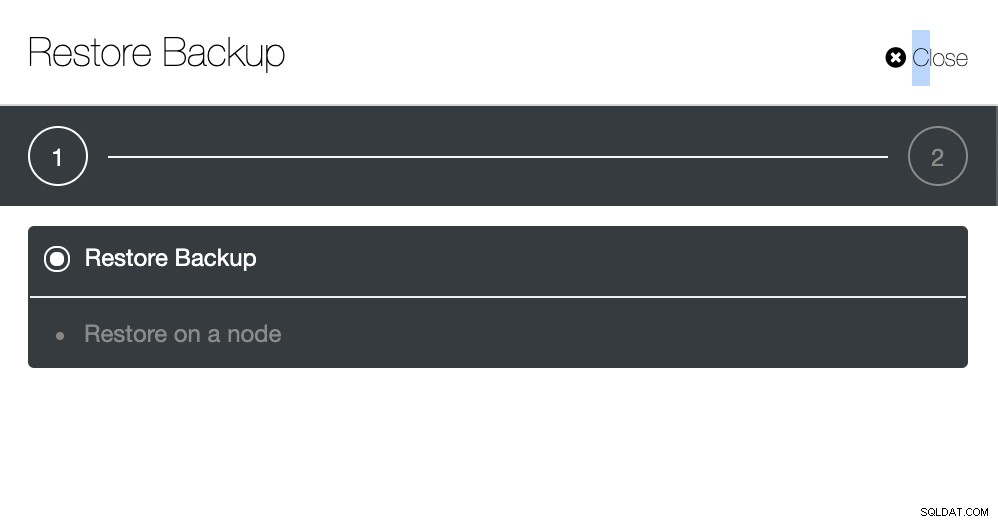
दूसरा चरण
आपको यह चुनना होगा कि किस बैकअप को पुनर्स्थापित करने की आवश्यकता है।
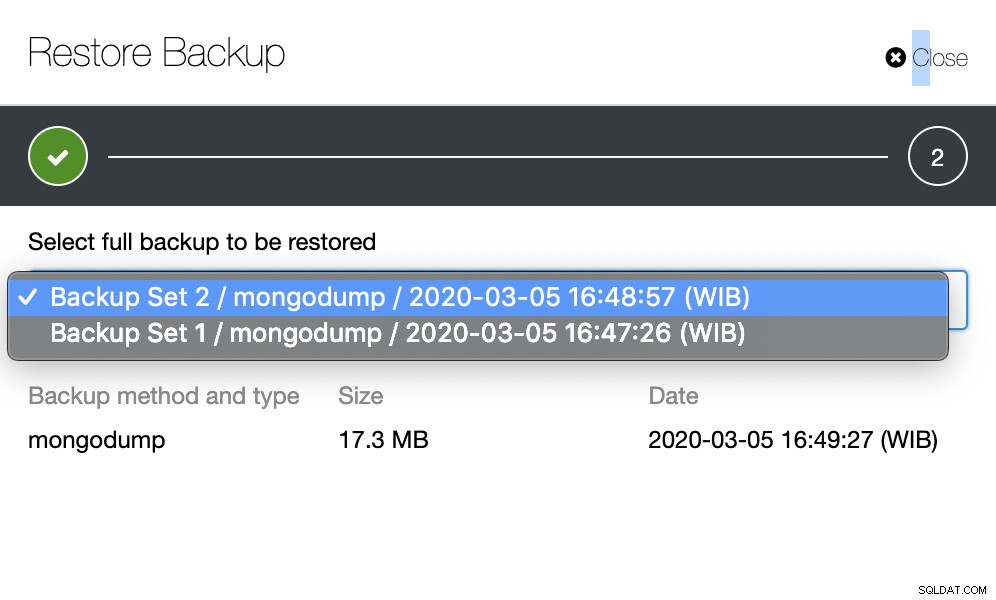
तीसरा चरण
सारांश की समीक्षा करें...
